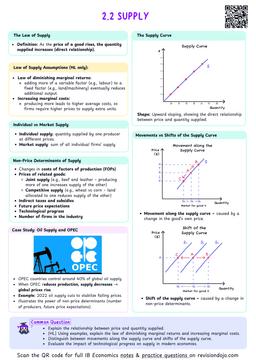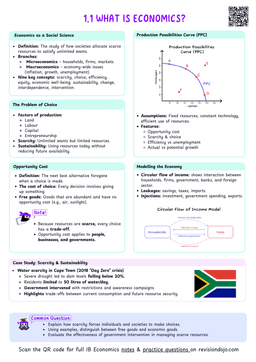- The Price Level (PL) of an economy is not the only factor that affects its aggregate demand (AD).
- While changes in the PL cause movements along the AD curve, changes in the determinants of the AD components (C+I+G+(X-M)) shift the AD curve.
Determinants of aggregate demand
Factors that shift the aggregate demand curve by affecting its components: consumption (C), investment (I), government spending (G), and net exports (X - M).
The determinants of AD components covered in the IB curriculum are:
- Consumer spending (C) determinants:
- Consumer confidence.
- Interest rates.
- Wealth.
- Income taxes.
- Level of household indebtedness.
- Expectations of future price level.
- Investment (I) determinants:
- Interest rates.
- Business confidence.
- Technology.
- Business taxes.
- Level of corporate indebtedness.
- Government spending (G) determinants:
- Political and economic priorities.
- Net exports (X-M) determinants:
- Income of trading partners.
- Exchange rates.
- Trade policies.
The most important thing to note in this topic is that:
- Changes in price level cause changes the quantity of real GDP demanded (causing a movement along the AD curve).
- Changes in the determinants of AD components lead to changes in the quantity of real GDP demanded at all possible price levels (causing a shift of the demand curve).
- A rightward shift indicates that at all given price levels, the total quantity of real GDP demanded increases.
- A leftward shift indicates that at all given price levels, the total quantity of real GDP demanded decreases.

In IB Economics long-answer questions, it is very important to explain processes step-by-step, without skipping any steps.
In this section, the effect of changes in the determinants of AD components will be explained in such way.
Consumer spending (C) determinants
Consumer confidence
Increased consumer confidence → rightward shift in AD
- Consumer confidence refers to the level of optimism consumers feel about the economy's overall condition and their personal financial situation.
- If an event causes consumers to feel more confident about the economy's condition or their personal financial situation, consumer confidence increases.
- Increased consumer confidence causes consumers to increase their spending, since they are confident in the economic conditions.
- Since consumer spending is one of the components of AD, higher consumer spending leads to higher AD at all price levels.
- Resultantly, an increase in consumer confidence shifts the AD curve to the right (AD1→AD2).

Decreased consumer confidence → leftward shift in AD
- Consumer confidence refers to the level of optimism consumers feel about the economy's overall condition and their personal financial situation.
- If an event causes consumers to feel less confident about the economy's condition or their personal financial situation, consumer confidence decreases.
- Decreased consumer confidence causes consumers to reduce their spending, as they feel uncertain or pessimistic about the economic conditions and want to retain their financial resources.
- Since consumer spending is one of the components of AD, lower consumer spending leads to lower AD at all price levels.
- Resultantly, a decrease in consumer confidence shifts the AD curve to the left (AD1→AD2).

Interest rates
Interest rates
Interest stated as a percentage. It represents the proportion of the amount of money borrowed charged as interest.
Increased interest rates → leftward shift in AD
- Interest rates refer to the cost of borrowing money or the reward for saving.
- If interest rates rise, borrowing becomes more expensive for consumers, while the incentive to save increases.
- Hence, increased interest rates discourage consumers from spending, as they have a higher incentive to save.
- Since consumer spending is a component of AD, lower spending leads to lower AD at all price levels.
- Resultantly, an increase in interest rates shifts the AD curve to the left (AD1→AD2).

Decreased interest rates → rightward shift in AD
- Interest rates refer to the cost of borrowing money or the reward for saving.
- If interest rates fall, borrowing becomes cheaper for consumers, while the incentive to save decreases.
- Hence, decreased interest rates encourage consumers to spend, as the as the cost of financing is lower.
- Since consumer spending is a component of AD, higher spending leads to higher AD at all price levels.
- Resultantly, an decrease in interest rates shifts the AD curve to the right (AD1→AD2).

Wealth
Increased wealth → rightward shift in AD
- Wealth refers to the total value of a household’s assets, such as property, stocks, and savings, minus liabilities.
- When wealth increases, consumers feel more financially secure and confident about their economic situation.
- This encourages higher consumer spending, as households are willing to use their additional wealth to buy goods and services.
- Since consumer spending is a component of AD, increased spending leads to higher AD at all price levels.
- Resultantly, an increase in wealth shifts the AD curve to the right (AD1→AD2).

Decreased wealth → leftward shift in AD
- Wealth refers to the total value of a household’s assets, such as property, stocks, and savings, minus liabilities.
- When wealth decreases, consumers feel less financially secure and more uncertain about their economic situation.
- This discourages consumer spending, as households may cut back on expenditures to compensate for the loss in wealth.
- Since consumer spending is a component of AD, reduced spending leads to lower AD at all price levels.
- Resultantly, a decrease in wealth shifts the AD curve to the left (AD1→AD2).

Income taxes
Income taxes
Taxes paid by households on their incomes.
Increased income taxes → leftward shift in AD
- Income taxes refer to taxes imposed by the government on households' incomes, which reduce disposable income.
- When income taxes increase, consumers have less disposable income to spend on goods and services.
- This discourages consumer spending, as households need to allocate more of their income to tax payments and less to consumption.
- Since consumer spending is a component of AD, lower spending leads to lower AD at all price levels.
- Resultantly, an increase in income taxes shifts the AD curve to the left (AD1→AD2).

Decreased income taxes → rightward shift in AD
- Income taxes refer to taxes imposed by the government on households' incomes, which reduce disposable income.
- When income taxes decrease, consumers have more disposable income to spend on goods and services.
- This encourages higher consumer spending, as households retain (and can spend) a greater share of their income.
- Since consumer spending is a component of AD, higher spending leads to higher AD at all price levels.
- Resultantly, a decrease in income taxes shifts the AD curve to the right (AD1→AD2).

Level of household indebtedness
Increased household indebtedness → leftward shift in AD
- Household indebtedness refers to the total amount of debt that households owe, such as mortgages, credit card debt, and loans.
- When an even causes household indebtedness to increase, consumers allocate more of their income toward repaying debt and less of it on spending on goods and services.
- This reduces consumer spending, as households prioritise debt repayments over consumption.
- Since consumer spending is a component of AD, lower spending leads to lower AD at all price levels.
- Resultantly, an increase in household indebtedness shifts the AD curve to the left (AD1→AD2).

Decreased household indebtedness → rightward shift in AD
- Household indebtedness refers to the total amount of debt that households owe, such as mortgages, credit card debt, and loans.
- When an even causes household indebtedness to decrease, consumers allocate less of their income toward repaying debt, leaving more income available for spending.
- This increases consumer spending, as households feel less constrained by debt obligations.
- Since consumer spending is a component of AD, higher spending leads to higher AD at all price levels.
- Resultantly, an decrease in household indebtedness shifts the AD curve to the right (AD1→AD2).

Expectations of future price level
Expectations of higher future prices → rightward shift in AD
- Expectations of future price levels refer to what consumers anticipate about how prices will change in the future.
- If consumers expect prices to rise in the future, they are likely to increase their spending now to avoid paying higher prices later.
- This causes an increase in current consumer spending, which is a component of AD.
- Since consumer spending is a component of AD, higher spending leads to higher AD at all price levels.
- Resultantly, expectations of higher future prices shift the AD curve to the right (AD1→AD2).

Expectations of lower future prices → leftward shift in AD
- Expectations of future price levels refer to what consumers anticipate about how prices will change in the future.
- If consumers expect prices to fall in the future, they are likely to decrease their spending now hoping to pay lower prices later.
- This causes a decrease in current consumer spending, which is a component of AD.
- Since consumer spending is a component of AD, lower spending leads to lower AD at all price levels.
- Resultantly, expectations of lower future prices shift the AD curve to the left (AD1→AD2).

Investment (I) determinants
Interest rates
Interest rates
Interest stated as a percentage. It represents the proportion of the amount of money borrowed charged as interest.
Increased interest rates → leftward shift in AD
- Interest rates refer to the cost of borrowing money or the reward for saving.
- If interest rates rise, borrowing becomes more expensive for business.
- Hence, increased interest rates make investing in new projects or capital equipment less attractive for firms. Additionally, higher interest rates encourage businesses to save rather than spend on investments.
- Since firms investment is a component of AD, lower investment leads to lower AD at all price levels.
- Resultantly, an increase in interest rates shifts the AD curve to the left (AD1→AD2).



